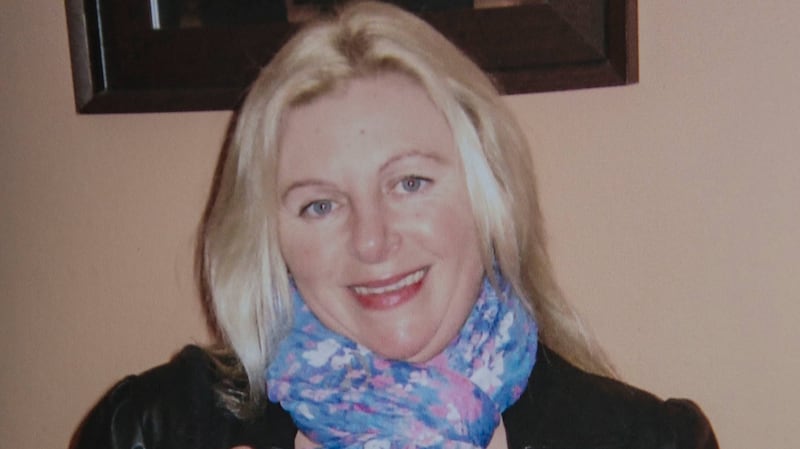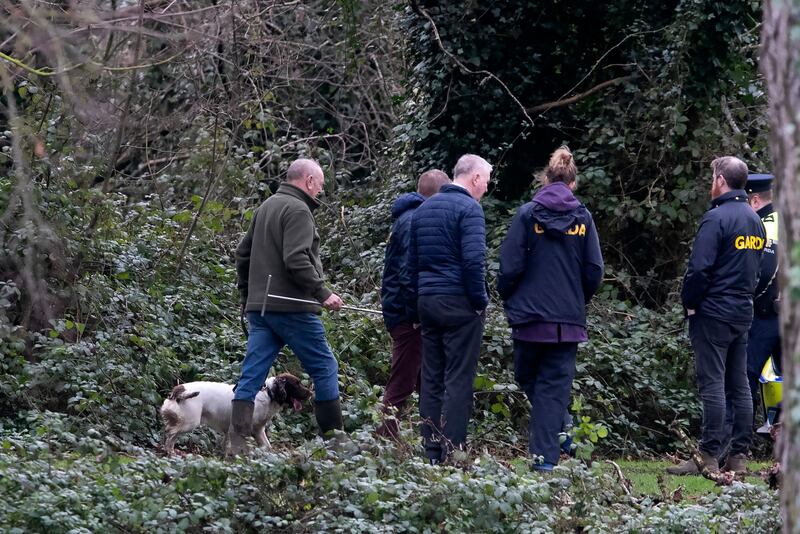The discovery by a cadaver dog last month of the body of missing Corkman Kieran Quilligan (47) in a gully in the east of the county highlighted yet again what an invaluable assistance man’s best friend can be to police forces in Ireland and elsewhere.
The discovery by cocker spaniel Charli of Mr Quilligan’s remains less than two hours after she and her handler began searching just off the Midleton to Whitegate road was the second time inside four months that a cadaver dog had led to a major breakthrough in an Irish murder investigation.
Last October, springer spaniel Fern and her handler had similarly helped Cork gardaí make a breakthrough in the search for missing Tina Satchwell (45) when the dog led them to a concrete area under the stairs in Ms Satchwell’s home in Youghal where they found her remains.

In both cases, Fern and Charli were provided by the Police Service of Northern Ireland (PSNI) on foot of a mutual assistance request from gardaí who are working to replace their own retired cadaver dogs.
READ MORE
The Garda Dog Unit currently has 24 dogs trained in general purpose policing, searching for drugs, cash and firearms, as well as explosive detection but it currently relies on third-party contractors and the PSNI when it needs victim-recovery dogs.
Just this week, the Garda brought in a third-party contractor to help search Santry Demense in Dublin for Icelandic father of four Jon Jonsson (41) who disappeared on February 9th, 2019, after leaving the Bonnington Hotel on the Swords Road where he had been staying on a visit to the capital to play poker.
The first recorded case of a dog sniffing out and finding human remains of a murder victim goes back to Germany over 200 years ago.
A court clerk was out walking his dog in the small village of Regendorf, some 130km north of Munich in 1808 when the dog became agitated near a shed. When the man notified police, they discovered the mutilated bodies of two young women who had gone missing some time earlier.
The shed belonged to fortune teller Andreas Bichel, who had enticed young women to his home by telling them he had a magic mirror in which they could see the image of their future husband. When Catherine Seidel and Barbara Resinger visited him separately, he killed them.
The Garda Dog Unit has 24 operational dogs trained in general purpose policing, searching for drugs, cash and firearms, and explosive detection but it relies on third-party contractors and the PSNI when it needs victim-recovery dogs
Dubbed Mädchenschlächter or The Bavarian Ripper, Bichel denied the murder of the two women despite the discovery of their bodies on his property and other circumstantial evidence linking him to their disappearance, but was found guilty and executed for his crimes in 1809.
According to the American Kennel Club, dogs have about 200-300 million scent receptors in their noses, compared to about six million in humans and the scent regions of their brains are roughly 40 times larger than those of humans.
But, according to Prof Cat Warren, author of What the Dog Knows, organised attempts to use dogs in murder investigations are relatively new, beginning in the 1970s after the US army used dogs to track Viet Cong forces in the Vietnam War. They then began to look at what dogs could do in peacetime.
Warren’s fellow American Andrew Rebmann, co-author of The Cadaver Dog Handbook: Forensic Training and Tactics for the Recovery of Human Remains, explains that the first dog trained exclusively for cadaver searches by a police department began work in New York state in 1974.
[ Tina Satchwell: ‘Funny, bubbly and independent. She was kind and considerate’Opens in new window ]
Police were investigating a homicide in Oneida County that involved multiple buried victims in a large forest when state trooper Ralph Suffolk and his golden Labrador, Pearl, found the body of Syracuse student Karen Levy (18) which later led to the arrest and conviction of her killer, John Harris.
But before Rebmann wrote the book, he was a pioneer in the use of cadaver dogs. While working as a Connecticut state trooper he completed his first cadaver dog training course and went to work with German shepherd, Rufus.

Rufus proved just how diligent cadaver dogs can be when, in 1980, he searched the home of businessman Kent Oppel (29) in Monroe, Connecticut, and found the body of Oppel’s wife, Robin (28), buried four feet down, covered in lime under a newly laid concrete patio.
Six years later, Rebmann had an even more publicised success when, with R
ufus’s successor, Lady, he helped solve the baffling case of Danish-born flight attendant Helle Crafts (39) who vanished from the home she shared with her pilot husband, Richard, in Newtown, Connecticut.
A snowplough driver reported seeing a woodchipper operating during a snowstorm near the Crafts home around the time Helle Crafts disappeared and when Lady later searched the area, she found a sliver of a fingernail with nail polish on it that detectives were able to match to the missing woman.
The find enabled police build a case against Richard Crafts and, in 1989, he was given a 50-yea
r prison sentence for what became known as “The Woodchipper Murder”. It inspired a scene in the Coen Brothers’ film Fargo where Steve Buscemi meets a gruesome end.
In his book, Rebmann explains cadaver dogs find human remains because they are trained to pick up the scent of cadaverine and putrescine, two nitrogen-containing organic compounds produced by decomposing bodies .
Dogs have such an acute sense of smell they can get a scent of bone so even a body that has been in the ground for many years and decomposed to just skeletal remains can still be detected
Training cadaver dogs is something former Lancashire police officer Mick Swindells has developed a much-sought after expertise in after assisting police forces all over Europe to train dogs as well as being drafted in to help in some high-profile searches across the UK and Ireland for over 30 years.
A veteran of numerous searches including for the victims of Moors murderers, Ian Brady and Myra Hindley, Swindells has assisted the Independent Commission for the Location of Victims’ Remains in Northern Ireland. He also helped An Garda Síochaná on several notable Irish cases.
In 2018, he and his black Labrador, Ronnie, were drafted in to assist in the search for Tina Satchwell after gardaí received a report of suspicious activity in Castlemartyr Wood, only for the search for her to prove unsuccessful at that time.
[ Garda search for evidence about missing Icelandic man ends in north DublinOpens in new window ]
“We use a dog with a good hunting instinct like a Spaniel or a Labrador,” he says. “We don’t train the dogs to find meat, mother nature has already trained them to do that – the only thing we do is train the dogs to find a specific type of meat and, in the UK, we train them to do that using pig meat.”
“I train dogs based on rewarding positive behaviour, so the dog is searching for food and when they find the pig meat – I usually bury a whole pig so they are looking for blood, bone, tissue, hair – and they get their reward direct from the grave not from my pocket,” he adds.
In surface searching, Swindells keeps the dog on a long leash but when searching for buried bodies he lets the dog loose and how the dog indicates they have found something depends more on the handler than the dog with some handlers opting for scratching rather than barking.

One area where barking is the only option is in water searches as happens with Iain Marshall and his springer Spaniel Barra, whom Swindells helped train, when they carry out searches for bodies in the Clyde and other rivers and lakes in Scotland.
Says Swindells: “I like a subtle indicator myself but I know on the boat, Barra is at the bow of the boat, and he barks for Iain when he gets a scent in the water – we used a system of pullies to bring up a reward from the water for Barra when we were training him to detect a scent in water.”
Dogs are able to detect scents from gases rising in the water and the same principle applies to searches on land with handlers such as Swindells drilling holes in concrete or boring holes with an augur in normal ground to allow gases from putrefying flesh seep to the surface.
“We always probe the ground, and the dog smells the probe – I use a metre-deep augur to drill the hole and it’s like breaking the crust on a pie. We also use magnetometry to show if earth has been disturbed because earth in a grave is never as compact as earth formed by mother nature.
“Most murder victims are buried less than six feet down so when I work in 20m grids, I put out lines every metre so if I’m looking for a fresh adult, I will probe it every metre but if it’s an older grave or a child, I will probe it every half metre and let the dog smell each probe hole.”
Swindells points out dogs have such an acute sense of smell they can get a scent of bone so even a body that has been in the ground for many years and decomposed to just skeletal remains can still be detected.
“I’ve worked on a lot of cases from the Troubles and the oldest grave I’ve found was that of a young man from Belfast, Peter Wilson, who was abducted and killed by the IRA in 1973 and I helped find him with my dog, Sam, at Waterfoot Beach near the Glens of Antrim in 2010 – 37 years later.”
Swindells says a cadaver dog is best trained when they are 12-24 months old. They can be trained in eight weeks, but much depends on temperament. “You don’t want a dog that’s a scavenger, that will indicate every time it finds a Kentucky Fried chicken. You want a dog with a bit of sense about it.”
“We do about 800 holes in a 20m grid and the dog will put their nose over every single one of those and I could do three grids a day during a search so that’s 2,400 holes – it’s slow and laborious work but it’s very accurate and it can be hugely rewarding when you help find someone missing.”
- Sign up for push alerts and have the best news, analysis and comment delivered directly to your phone
- Find The Irish Times on WhatsApp and stay up to date
- Our In The News podcast is now published daily - Find the latest episode here



















